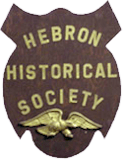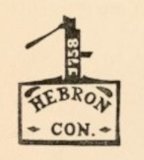
The Hebron Historical Society
Hebron, Connecticut
Enjoy Hebron - It's Here To Stay ™


Enjoy Hebron - It's Here To Stay ™

Matthew Troy - Director/Writer
 Born and raised in Hebron, Connecticut, Matthew Troy has been producing films since 1999. Sole proprietor of Patio Productions, his production company, Matthew works both in the creative and consumer world producing films that range from commercial promotional videos to 35mm narratives. Matthew is a May 2009 graduate of NYU's Tisch School of the Arts, with a focus on cinematography and film direction. He is also a volunteer Firefighter/EMT in his hometown.
Born and raised in Hebron, Connecticut, Matthew Troy has been producing films since 1999. Sole proprietor of Patio Productions, his production company, Matthew works both in the creative and consumer world producing films that range from commercial promotional videos to 35mm narratives. Matthew is a May 2009 graduate of NYU's Tisch School of the Arts, with a focus on cinematography and film direction. He is also a volunteer Firefighter/EMT in his hometown. |
 |
 |
Born in Hebron in 1814, Josephine (White) Griffing was educated at Burrows Hill School and Bacon Academy. She married Charles Griffing in 1835 and then left Hebron in 1842 for Litchfield, Ohio.
Josephine soon became a sought-after speaker for Abolition as well as Women’s Rights. Her lectures and writing brought her to national prominence.
In Washington, D.C. after the Civil War, she helped found the Freedmen’s Bureau, an organization to help newly-freed slaves acquire the skills they would need to survive in the post-war economy. She received backing from President Lincoln and Secretary of War Stanton in a bid to become first commissioner of the Freedmen’s Bureau. Ironically, however, the job was given to a man.
She worked tirelessly over the remainder of her life and helped find northern homes for more than 7,500 freed people. She also helped establish two industrial schools to help train destitute and unskilled women in a trade. Upon her death in 1872, her body was returned to Hebron’s Burrows Hill Cemetery. She was perhaps the bravest crusader ever to be born in our community.
For a small, rural Connecticut town, Hebron has played a surprisingly significant role in both the movement to abolish slavery in America and the movement to help freed slaves adapt to their changed circumstances after the Civil War.
Hebron’s involvement in the abolition movement centers around an episode in 1787, in which two slaves, Cesar and Lowis Peters and their children were abducted from their Hebron home and then rescued by their white neighbors, who out-maneuvered the slavers with a fake arrest warrant. This event is the earliest documented abolitionist movement in New England.
 Cesar Peters and the Slave Trader Sketch by Carol A. Taylor
Cesar Peters and the Slave Trader Sketch by Carol A. Taylor
The Hebron connection to abolition continued through the efforts of Josephine (White) Griffing, a Hebron native who later became a nationally recognized speaker for abolition and women’s rights in the years before the Civil War. After the war, Josephine was a leader in establishing job training programs through the Freedmen’s Bureau to help former slaves adapt to the new industrial economy.
For more information about Hebron’s connections to slavery, abolition and freedmen’s assistance, click on the following links:
 In 1787, the Reverend Samuel Peters, a former Hebron resident living in England, arranged to have many of his assets sold, including his slaves, to help make financial ends meet. On September 27th of that year, Peters’ Hebron slaves, Cesar and Lowis Peters, and their children were taken forcibly from Hebron by a slave trader and brought to Norwich to be loaded on a ship headed for South Carolina.
In 1787, the Reverend Samuel Peters, a former Hebron resident living in England, arranged to have many of his assets sold, including his slaves, to help make financial ends meet. On September 27th of that year, Peters’ Hebron slaves, Cesar and Lowis Peters, and their children were taken forcibly from Hebron by a slave trader and brought to Norwich to be loaded on a ship headed for South Carolina.
Cesar & Lowis’s white neighbors felt that the abduction of their friends was unfair and devised an ingenious scheme to get them back from the slavers. They made up a story that Cesar had stolen some goods from a local tailor and got the local justice of the peace to issue an arrest warrant. They presented the arrest warrant to the slaver, and succeeded in bringing Cesar and Lowis back to Hebron.
This event, one of the most dramatic freedom stories in our state’s history, earned the town of Hebron a designation by The Amistad Committee in 2007 as part of the Connecticut Freedom Trail.
This well researched history of Rev. Peters, his slaves and their attempted abduction was written by F.C. Bissell, Hebron Historian. Mr. Bissell also wrote the history of Hebron’s first 100 years in the report of the Hebron Bicentennial Celebration of 1908.
In 1789, Cesar & Lowis applied for emancipation from the Connecticut General Assembly, sitting in New Haven at that time. According to the 1789 deposition of David Sutton, their “guardian”, Cesar had been unable to do much work since his rescue, “being badly hurt as I understood by irons being put on his wrists.” The following documents are related to that application.
The Connecticut State Library has just added the lawsuit that Cesar Peters filed against John and Nathaniel Mann in 1789 and 1790. You can view the originals at http://cslib.cdmhost.com/cdm4/browse.php?CISOROOT=%2Fp128501coll7, but they are issued page at a time. We've put the two lawsuits in Adobe Acrobat files for easier viewing, and are currently working on transcriptions.